On View
Artist Shih Chieh Huang on Using New Technology to Bring Trash to Life
For his new Worcester Art Museum show, the artist transforms plastic bags and computer fans into living, breathing art.

For his new Worcester Art Museum show, the artist transforms plastic bags and computer fans into living, breathing art.

Sarah Cascone

Shih Chieh Huang creates art from unlikely sources: garbage bags, computer fans, Christmas light faders. His motorized sculptures—delicate tentacles made out of plastic bags that light up as they inflate and deflate—take on a life of their own. They float like giant bioluminescent sea creatures from an age that is at once prehistoric and futuristic.
“One recurring concept in my work is animating these inanimate objects, bringing life to every day materials,” the Taiwan-born, New York-based artist told artnet News.
For his latest exhibition, “Reusable Universes: Shih Chieh Huang,” on view at the Worcester Art Museum through November 12, Huang created a kinetic sculptural installation of more than 100 elements—his largest to date. It is nothing less than otherworldly.
I first encountered Huang’s work at the 2016 Armory Show, where crowds gathered around his glowing Disphotic Zone, which resembled a giant robotic jellyfish. Later that year, at Bushwick Open Studios, I wandered into his massive, heavily foot-trafficked space at 17-17 Troutman, which felt like some kind of strange biology lab.
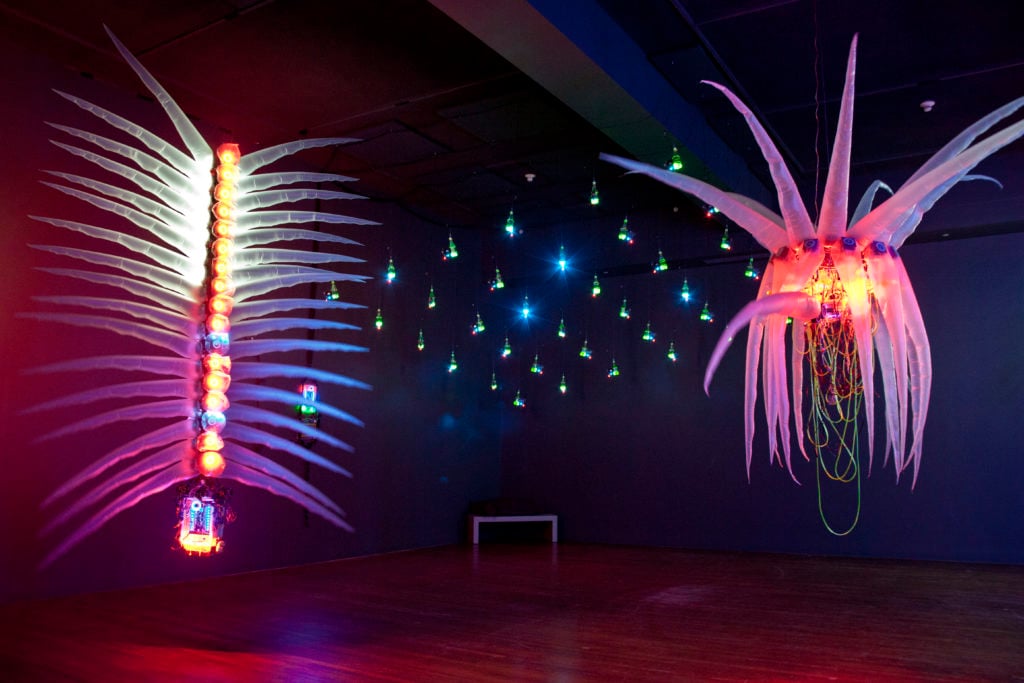
“Reusable Universes: Shih Chieh Huang” at the Worcester Art Museum, installation view. Courtesy of Shih Chieh Huang.
The feeling is different at the museum: The darkened room transports you suddenly to the depths of the ocean, or the far reaches of outer space. It is quiet, peaceful, and reflective.
For this edition of “Origin Story,” which explores the backstories of individual works of art, Huang takes us through the evolution of his work and the process of putting together the immersive installation, Reusable Universes, at the Worcester Art Museum.
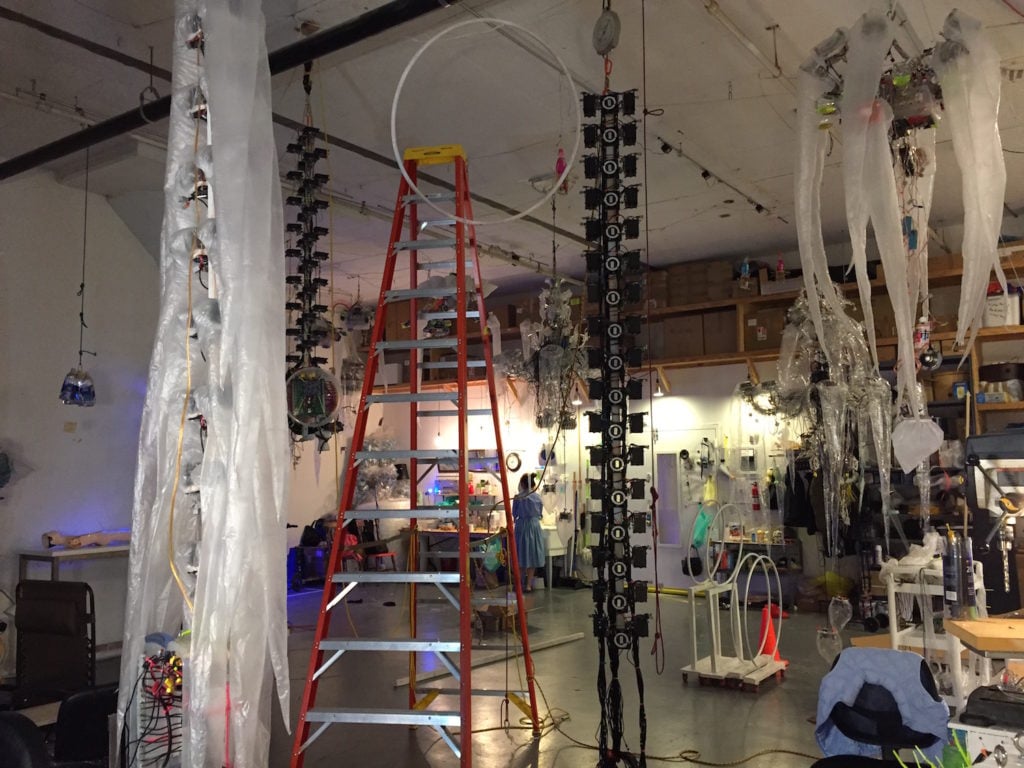
Work in Shih Chieh Huang’s studio. Courtesy of Shih Chieh Huang.
You’ve developed a unique type of motorized sculpture featuring plastic bags. How long have you been making work in this vein?
It goes way back. The earliest I remember, I was in college, in 1995 or ’96, and I bought a mattress that came in a big bag. It was summertime in San Diego, and I wanted to make a cooler space. I used a box fan to inflate the mattress bag with air, and I sat inside.
I was going to use it my working space. Then I thought, this space itself is kind of interesting. I started experimenting with plastic bags of different thicknesses, using different kind of fans. I was using those plastics you get at Home Depot when you’re painting to cover up the furniture. I would cut them and seal it into different shapes.
I started to use thinner and thinner plastics. They become more organic in their feel and the movement becomes more soft. That kind of started the process, just experimenting with these plastics and fan materials.
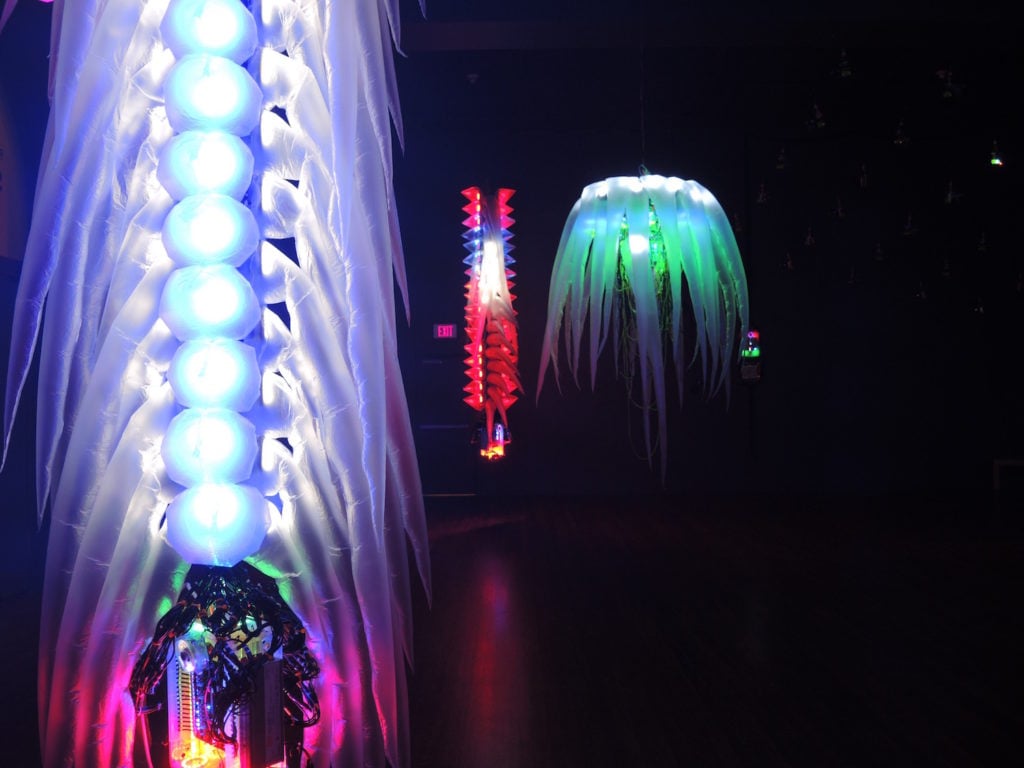
“Reusable Universes: Shih Chieh Huang” at the Worcester Art Museum, installation view. Courtesy of Sarah Cascone.
How did you start animating your sculptures?
At first, I was using basic stuff, like Christmas light faders, a dual two-channel outlet that lets you plug in two different color lights. It alternates the channels to change the color.
I wanted to learn some physical computing, so I snuck into a college class and learned programming. I was able to use the programming method BASIC Stamp to start animating my work. That allowed for more variation of the speed and the rhythm, but I wanted to have more complexity and control of the movement. I was struggling to develop a new control board system for several years. Everything got very, very complicated.

A work from Shih Chieh Huang’s “Reusable Universes: Shih Chieh Huang” in progress. Courtesy of Shih Chieh Huang.
Then I found an app that is used for concerts and theater lighting. It was able to communicate with the board that I had been building, so I didn’t have to write code any more. I can visually see how everything is controlled; each tentacle, each bag. That really changed how I was able to choreograph these movements for the Worcester show.
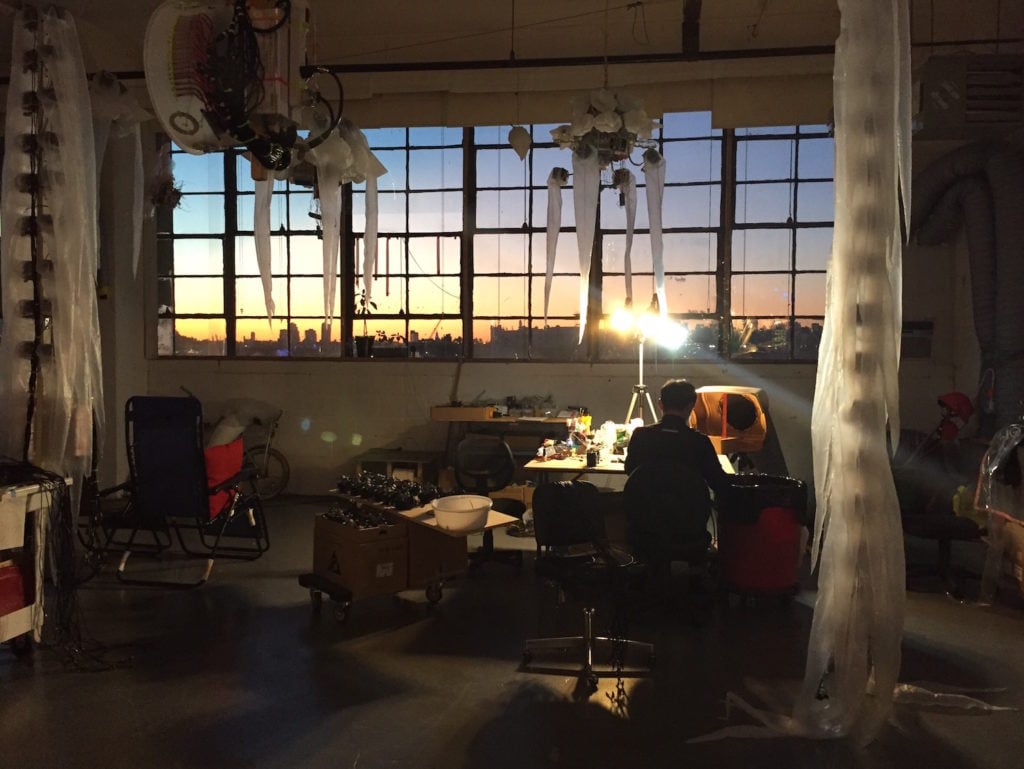
Shih Chieh Huang in his studio. Courtesy of Shih Chieh Huang.
How did you design the installation for the Worcester Art Museum, and did you face any challenges in bringing your vision for the show to life?
Sometimes a museum has certain regulations about what you able to do with the space. Here, we were able to darken the ceiling, which was very high. There were two beams on the ceiling where I wasn’t allowed to hang things. I had to work around that, avoiding the tracking lights and the alarm systems. There was a lot of back and forth in the planning process.
I wanted to do something very tall so the viewer would really respond to the height of the structure when they’re standing next to it, so I started making these vertical pieces. Then I had to rebuild a lot of them to make sure I could ship everything and still have the crate fit through the museum’s entrances. I redesigned some pieces so I could disassemble the control board system from the body.
One piece has liquid, and I was a little bit hesitant do that because the show is four months long and liquid does evaporate. So I did some modifications, and it should be able to run this long without a refilling—but I’ll find out.
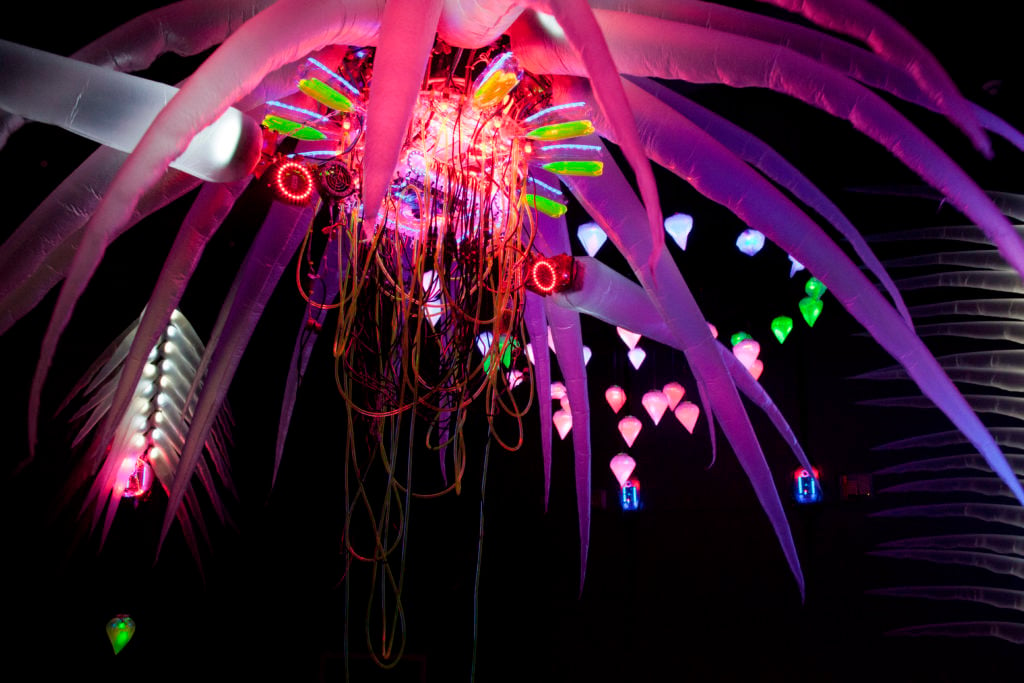
“Reusable Universes: Shih Chieh Huang” at the Worcester Art Museum, installation view. Courtesy of Shih Chieh Huang.
What was the inspiration for Reusable Universes?
[As I worked on “Reusable Universes”], I was watching a lot of these galaxy Milky Way-type of documentaries. In space, a lot of star clusters are joined together. I started thinking about if you clustered the sculptures together, you’d walk into this dark space and it would be almost like this creature, this structure, that rises out of the depths.
When you first look at it, you’re like, “Is that a creature?” And then as you get closer you realize it’s plastic bags and computer fans. So it becomes more of an experience of moving through the gallery.
Sometimes when I look at these pieces, I just see trash bags and fans, controlled in a certain way so that they’re moving; it’s very straightforward. But sometimes, I think that’s a cell, heart, a lung, a sea creature. I don’t want to tell the viewer how they should be looking.

A work from Shih Chieh Huang’s “Reusable Universes: Shih Chieh Huang” in progress. Courtesy of Shih Chieh Huang.
What is the significance of using these every day objects and transforming them so dramatically? Is your work a rumination on how our world has become more technologically advanced? A way to recuse things that have been overlooked?
I use these materials because I find them very familiar, very friendly. I collect a lot of these materials when I am traveling. In my studio there’s a wall of the stuff I collect from different dollar stores. I feel like I relate to those objects a little more.
I was invited to do a project in upstate New York, and I remember walking through these trails and seeing the garbage left behind by hikers. I thought it would be interesting to put cooling fans into these bags and have them breathe. I set it on a timer so that as people were walking by, they would see these pile of garbage in the woods, and one of the bags would just come alive and start breathing.
I thought that was really funny—[the idea] that people had thrown these bags away and now they had come alive, and had kind of taken over the world. And then I started thinking, What happens when these bags grow up. Do they become more complex things?
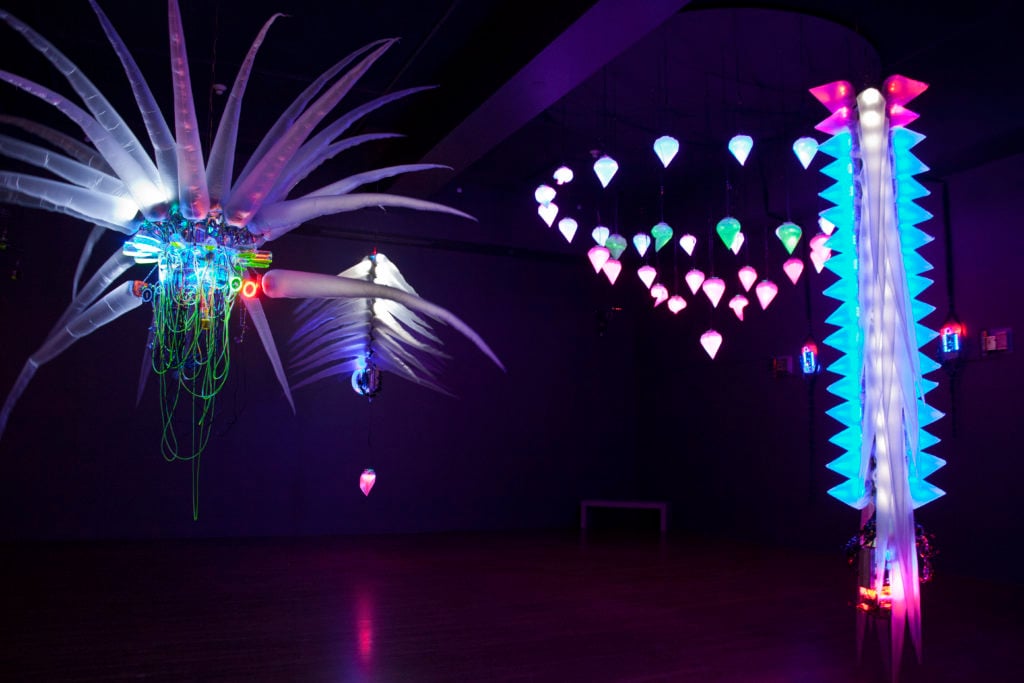
“Reusable Universes: Shih Chieh Huang” at the Worcester Art Museum, installation view. Courtesy of Shih Chieh Huang.
I guess I’m not very conscious of thinking about recycling. I think more about repurposing, using up a material. If I’m thirsty I buy a bottle, and I drink the water and now I have the bottle. If I use that bottle, then it’s more [like] recycling.
But sometimes I’ll see a bottle and I like the shape of it, and I’ll get that bottle and drink the liquid because I want to use that bottle. I do notice though, the prettier the bottle, the worst the drink tastes. They spent a lot of time time designing that bottle because the drink inside is not very tasty!
“Origin Story” is a column in which we examine the backstory of an individual work of art.
“Reusable Universes: Shih Chieh Huang” is on view at the Worcester Art Museum, 55 Salisbury Street, Worcester, Massachusetts, June 24–November 12, 2017.